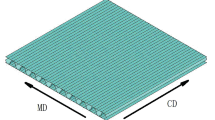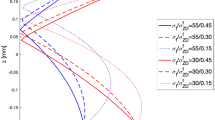Abstract
This paper shows the technological development for manufacturing corner angle sections or cardboard. Its manufacture involves splicing sheets (liners) of different weight Kraft papers joined with white glue. The thickness and strength of each profile is determined by the amount of spliced leaves and paperweight. There are two types of finishing in the profile, which are: natural finish Kraft wrapping paper and the white paper envelope. The second one is used to print images or logos on the exterior face for advertising purposes. They can withstand bending stresses for supporting buckling in horizontal and vertical position. These profiles are mainly used for packaging, protect corners, transportation and storage. A machine for manufacturing specialized linear process to obtain the required thickness is used. In this article, the basic load of an angular profile is analyzed by the finite element method using ANSYS 14 ®. Mechanical design considerations based on the mechanics of composite materials and the theory of laminated beams are considered. With the results of this analysis, load capacities like bending, buckling and deformation profiles are obtained. Furthermore, a comparison of three thicknesses of angular profiles supporting the mentioned loads is also presented.
Similar content being viewed by others
References
T. Nordstrand, Composite Structures, 27, 317 (1994).
Z. Aboura, Composite Structures 63, 53 (2004).
A. Miravete, Materiales Compuestos, Tomo I. Edited by INO Reproducciones Zaragoza, 181 (2000).
J. Tryding, In-Plane Fracture of paper, Report TVSM-1008. Edited by Lund University, Division of Structural Mechanics, Sweden, 2 (1996).
G. Baum, The elastic properties of paper: a review, IPC Technical paper series 145 (1987).
L. Hollaway, Polymers Composites for Civil and Structural Engineering, Edited by Blackie Academic & Professional, (1993).
S. Timoshenko, Theory of plates and shells. 2nd Ed. McGraw-Hill Classic Text Book Reissue, 396 (1987).
H. Hahn, S. Tsai, Journal of Composite Materials, 7, 102 (1973).
ANSYS Tutorial 2014, Shell 281.
J.L. Batoz, K.J. Bath, Int J Numer Meth Eng., 15, 812 (1980).
A. C. Gilchrist, J.C. Suhling, Mech Cellulosic Mat, 85, 7 (1999).
T. Nordstrand, Composite Structures, 30, 51 (1995).
A. Damatty, A. Mikhael, Thin-Walled Struct, 38, 65 (2000).
J.L. Batoz, K. A. Bath, search for the optimum three-node triangular plate bending element. Edited by Rapport 82448-8, Massachusetts Institute of Technology, (1978).
Acknowledgments
Instituto Politécnico Nacional, SEPI ESIME Unidad Azcapotzalco, SIP Project No. 20140927 and Consejo Nacional de Ciencia y Technología CONACYT.
Author information
Authors and Affiliations
Corresponding author
Rights and permissions
About this article
Cite this article
Rico, M., Sandoval, J.M., Flores, L. et al. Analysis of the Mechanical Behavior of a Paperboard Profile. MRS Online Proceedings Library 1766, 139–148 (2015). https://doi.org/10.1557/opl.2015.421
Published:
Issue Date:
DOI: https://doi.org/10.1557/opl.2015.421




